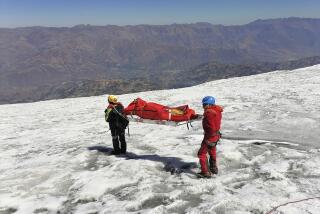Movie review: ‘The Wildest Dream’
- Share via
The most famous comment about the reason for climbing Mt. Everest was made by a man who never made it to the top. Or did he?
That would be British mountaineer George Mallory, who replied, “Because it’s there,” when asked why he wanted to conquer the highest peak in the world. Mallory looked on his quest as “the wildest dream,” and an absorbing new documentary called “The Wildest Dream: Conquest of Everest” deals with the climber’s fate and his legacy in an unexpected combination on ways.
Mallory, last seen 800 feet from the summit, ended up disappearing and then dying on Everest in early June 1924. His body was not found until May 1999, when top American climber Conrad Anker found it frozen into the mountainside.
Though letters were found on Mallory’s body, missing was the photograph of his wife, Ruth, that he always carried with him, a photograph the climber had promised he would leave on Everest’s summit if he got there.
Mountaineers argue to this day whether Mallory made it to the top or not, and that question personally haunted Anker after he discovered Mallory’s body (an event that is re-created in the film). In collaboration with director Anthony Geffen, Anker put together an expedition that would retrace Mallory’s steps with an eye toward seeing whether that question could be answered.
Solidly directed by Geffen, a TV documentary veteran making his theatrical debut, “The Wildest Dream” goes back and forth between its two narratives, between the historical drama of Mallory’s achievement and the present day challenges of Anker’s quest.
To tell both of these stories, “Dream” adroitly mixes a variety of material, including contemporary interviews (Mallory’s granddaughter is one subject), fascinating vintage newsreels, beautiful and exciting color footage shot on Everest and discreet re-creations of historical events that are overly earnest at times but never get in the way. Both narrator Liam Neeson and reading voices Natasha Richardson, Hugh Dancy and Alan Rickman do exceptionally strong work as well.
Though Anker’s personal story turns out to be of considerable interest, it is Mallory’s that is the most compelling and stays with us longest. A man who thrived on adventure, risk and pushing limits, Mallory lived a life that was more dramatic than most fiction.
Someone who found his vocation young, climbing the church steeple of his English village when he was seven, Mallory was an individual with absolutely no fear of heights. He was also, as photographs and footage attest, drop dead handsome, and he and his wife, Ruth, were charismatic romantics who wrote rapturous letters to each other.
But Ruth had a rival for her husband’s passion, and that was Everest, a mountain he fell in love with before he’d even seen it. Mallory’s 1924 expedition was his third and one his wife did not want him to take, but he couldn’t accept the idea that someone else might get to the summit before him.
Though they wore awkward hobnail boots and gabardine outerwear and used primitive oxygen systems, Mallory and his young climbing partner Andrew “Sandy” Irvine made up for these deficiencies with unquenchable zeal for the experience. “There is no dream that mustn’t be dared,” Mallory felt, with Irvine adding, “If I have to die, there would be no finer death.”
Ever since he discovered Mallory’s body, Anker had been obsessed with whether he and Irvine reached the summit before they died. Death, as it turned out, had been a factor in Anker’s climbing life as well. In 1999, he survived an avalanche that killed Alex Lowe, his best friend and climbing partner; Anker eventually married Lowe’s widow, who is shown as understandably concerned about this new expedition.
A key piece of evidence in the Mallory question was whether it was physically possible to free-climb the 90-foot sheer rock face known as the Second Step, an obstacle that had to be traversed on the way to the summit. To test this, Anker, his young climbing partner Leo Houlding and their team removed a set of stairs that had been placed there in 1975 by Chinese climbers.
What happened to these men on that ascent is fascinating, though factors like differences in gear between 1924 and today means that definitively answering the question of how far Mallory climbed is not possible. Which seems, somehow, just as it ought to be.
More to Read
Only good movies
Get the Indie Focus newsletter, Mark Olsen's weekly guide to the world of cinema.
You may occasionally receive promotional content from the Los Angeles Times.











